Alba SE (Square End) Soprano D Whistle Review
(Review written May 2003)
- Preface
- Ok. promised I'd come back to the Alba SE review after I'd played with the whistle a while, and it's now been 2 weeks. Here's the workout I gave the whistle over the last two weeks: Whenever I took a quick drive somewhere, I'd take this whistle to play at stoplights and the like. I've taken the whistle to 3 band practices and used it nearly exclusively during each practice. I used this whistle to entertain my son as he picked flowers in the back yard. I've taken it to 2 sessions. I got this whistle on a Gaelic Crossings "whistle tour" (see the Syn review for an explanation of these!)
- At a Glance
- Whistle Reviewed
- Alba SE (Square End) Soprano D Whistle
- Models Available
- soprano D
- How Acquired
- Construction
- aluminum, unknown fipple plug material, aluminum tuning slide incorporating teflon tape.
- Price at Time of Review (in US Dollars unless otherwise noted)
- $180 U.S. (as of April 13, 2005--I have edited this price because the shop that carried this whistle in the US is no longer affiliated with Alba Aerophonics).
- Available From
-
Big Whistle
- Appearance
- This whistle is pretty interesting. The knurling on the tuning slide kind of reminds me of some of the metalshop projects I saw in my high school.
-
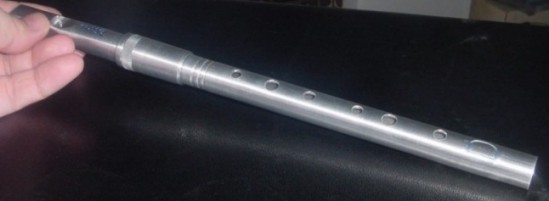
You can see all of the decorative features in this picture, such as the rings and the textured tuning slide. The holes are round, aligned down the middle of the body, and are not chamfered. After having it more than a couple minutes, I noticed that while the body has a brushed aluminum finish, the mouthpiece does not, and is slick and shiny like a Burke. You can see that in this picture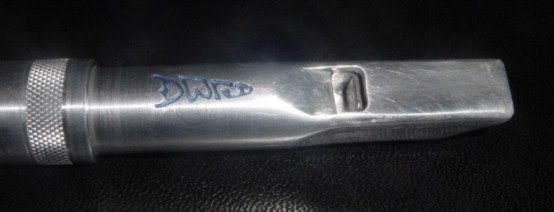
It's not really noticeable from a distance. I imagine that it'd be harder to get the brushed aluminum texture on a square head. You can see from the picture that the head is well-formed, the alba logo is professionally placed, and see the knurling on the tuning slide. Here's another picture of the whistle, from a different angle.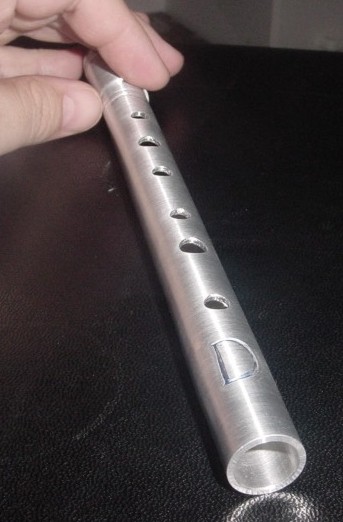
I only had two reservations about the looks of the whistle. The first was the large-ish hand-drawn D. It just doesn't fit with the style of the whistle, as you can see here: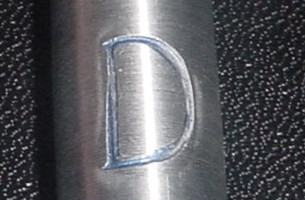
At session, EJ Jones (piper for Clandestine and The Willow Band) thought this whistle looked kind of like a Craftsman tool and was eccentric and kinda neat. I agree, and think that a smaller, and more stamped-looking D would have fit better with the whistle's overall appearance. I'm unsure why the Alba logo is professionally stamped, but the D looks like it was carved with a Dremel.The second reservation I had was an odd discoloration on the fipple block
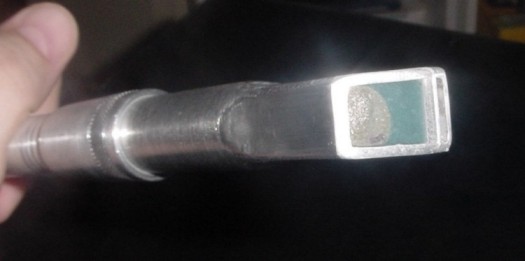
I noticed this immediately. I was concerned that there was something stuck on the fipple, but it doesn't feel like it. It just appears to be an odd discoloration. I've since found out later that this was a decoration. At the time I had this whistle, Stacey was experimenting with putting decorations on the fipple, and has since perfected the technique. The tuning slide, as I previously mentioned, incorporates teflon tape in it's construction.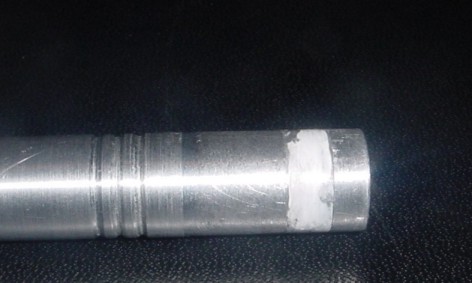
The teflon appears well-attached. It never came loose in all the times I adjusted the tuning on this whistle. It also appears to be somewhat counter-sunk into the whistle slide. I'm guessing it's here to help mitigate some of the metal-on-metal feel, and prevent any air leaks. I did not lubricate the slide (since it wasn't my whistle) and there is a little 'metal on metal' feel but it is only slightly noticeable. For a whistle of this price, I think I would have preferred O-rings, cork, or some other tuning slide mechanisim, but the teflon seems to work. The whistle is slightly sharp when the slide is all the way in, exactly as it should be.
- Playing Characteristics
- This whistle is a bit breathy, with a small amount of chiff. It's not as pure as the 'pure playing' whistles, but not as reedy-ish as my Silkstone alloy.
-
Sound clips of the whistle:
Drunken LandladyVolume: This whistle is loud loud LOUD. I originally thought it wasn't as loud as my Copeland. I was wrong. I was way under-blowing this whistle, and when given it's full head, is easily the loudest whistle I've blown. It *can* be blown softer, but when given the breath pressure required to bring everything into tune, it's a heck of a loud whistle. It'd be great for outdoors play, but may be even too loud except for really rowdy sessions. It's certainly too loud for inside my house, and I didn't really hear this whistle's full voice until I had it outside. At the sessions I took it to, I sat right next to the accordion player, and he didn't drown me out. When I recorded this whistle, I lowered the microphone input balance to half-way--the first time I've ever done that for a whistle--if that gives any indication to it's volume.
Responsiveness: This whistle is not as responsive as some of the other high-end whistles I own, such as my Busman or my Copeland. The ornaments don't seem to leap out at me as crisply as on my more-responsive instruments. I would reserve another whistle for my fast playing.
Tuning: The instrument, when blown with the proper breath control, is in tune. I originally thought the 2nd octave was quite flat when I first fiddled around with it, until I got it outside and realized I was just blowing way under the whistle's breath requirements. My only tuning complaints are that two notes require noticeably lower breath requirements than the rest of the whistle. To breathe the first octave D in tune, you have to blow it much softer than any other note on the whistle. When blown at comparable pressures, the note can be around 30% of the way to Eb. The first octave B didn't require as drastic breathing adjustment, but still must be blown softer than the surrounding notes to fall into tune. All of the other notes only required very subtle breathing adjustments to bring in line.
C-natural: OXXOOO produces a strong in-tune C-natural. For those who use different fingerings, dropping any other fingers (OXXXOO for instance) flattens the note beyond acceptable levels. OXOOOO (which i use on one or two fast tunes as a shortcut) makes a C-Natural about 15 cents sharp of true.
Hole size and placement: This whistle has holes on the smallish size, which I hear is good for small hands. I've never had problems sealing any whistle though except my Susato low G, so I can't really compare for you. The holes seem to be well-spaced, and I don't find any particular crowding or stretching required to play comfortably.
Air volume requirements: Average. This whistle allows you to get a decent amount of music out of it between breaths (unlike my Copeland, for instance, which requires a great deal more breathing).
Air pressure requirements: Very high. It seems to be true of most loud whistles I own that they require either lots of breath, or lots of pressure, or both. As you move up the scales on this whistle, the breath pressure requirements ramp up considerably. As noted in "tuning" above, I originally thought this whistle played flat, until I realized that I was just under the breath pressure requirements. At the top of it's range, you really have to be aggressive. The upper-half of the second octave can be compared to my Chieftain soprano D. For me personally, this is my biggest complaint. I prefer more easy-blowing whistles in the second octave. (For those who've known me for a while from C&F, you'll recall I sold my soprano Chieftain for this exact reason, and it's also the reason I didn't buy a Sweetheart until he retooled the product line). However, that's a personal preference. There are many folks who like to put a lot of umph into their playing, and this whistle will fit them perfectly.
Clogging: Ok, lastly, the whistle, like most whistles I own, tends to play a bit 'wet'. I attribute a lot of that to Houston humidity, and maybe some to me being a wet player. This particular whistle is no exception, but tends to clear itself pretty quickly as I'm playing, probably because I'm already blowing pretty hard through it, which forces the condensation to blow out on it's own accord--not to imply that I'm blowing as hard as I would if I were clearing the whistle. Most every whistle I own has what I call its 'saturation point'. That's how long I can play the whistle at a gig before it clearing it between tunes is no longer enough, and I have to switch to a fresh whistle. Most of my metal whistles saturate at about half-way through a four-hour gig. My PVC silkstone lasts most of a gig. I haven't found a single whistle that'd last an entire gig. I haven't played this whistle until it's saturated, however, as I wish to save the owner the grossness of contemplating what that would mean when he gets it back. :)
- Summary
- Fairly average whistles. I would only really consider them if you needed a lot of volume. There are some things I'd change to bring them more in line with my personal preferences, but that's true of most every whistle I own. For me personally, the breath requirements are a killer, and would prevent me from buying one of these whistles. The fact that they aren't carried in the US any more also makes it hard for me to recommend this whistle. The fact that the dollar is so weak against the GBP means that for the price of this whistle, you can get much better whistles, such as Greenwoods, wooden Syns, Overton, Burke, etc. If you needed volume, a Sweetheart Professional Model runs about the same price, and is much more reponsive.